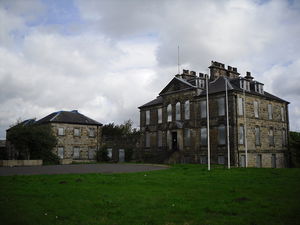Annotation:Cumbernauld House: Difference between revisions
No edit summary |
m (Text replacement - "garamond, serif" to "sans-serif") |
||
| Line 1: | Line 1: | ||
=='''Back to [[{{BASEPAGENAME}}]]'''== | =='''Back to [[{{BASEPAGENAME}}]]'''== | ||
---- | ---- | ||
<p><font face=" | <p><font face="sans-serif" size="4"> | ||
'''CUMBERNAULD HOUSE'''. AKA – "Cumberland House," "Cumernad House." Scottish, Air (4/4 time). G Major. Standard tuning (fiddle). AABB. Cumbernauld House [http://en.wikipedia.org/wiki/Cumbernauld_House] is a fine example of neo-classical architecture designed by fashionable architect William Adam and built for the Fleming family. It was completed in 1731. The last Lord Fleming, Earl of Wigton, died childless in 1747 and the estates passed to the Elphinstone family. Charles Elphinstone-Fleming, a retired Admiral, was laird from 1799–1840, and was for a time MP for Stirlingshire. | '''CUMBERNAULD HOUSE'''. AKA – "Cumberland House," "Cumernad House." Scottish, Air (4/4 time). G Major. Standard tuning (fiddle). AABB. Cumbernauld House [http://en.wikipedia.org/wiki/Cumbernauld_House] is a fine example of neo-classical architecture designed by fashionable architect William Adam and built for the Fleming family. It was completed in 1731. The last Lord Fleming, Earl of Wigton, died childless in 1747 and the estates passed to the Elphinstone family. Charles Elphinstone-Fleming, a retired Admiral, was laird from 1799–1840, and was for a time MP for Stirlingshire. | ||
<br> | <br> | ||
| Line 7: | Line 7: | ||
</font></p> | </font></p> | ||
[[File:cumberlnauld.jpg|300px|thumb|left|Cumbernauld House. (photo c. Steven Spier]] | [[File:cumberlnauld.jpg|300px|thumb|left|Cumbernauld House. (photo c. Steven Spier]] | ||
<p><font face=" | <p><font face="sans-serif" size="4"> | ||
''Source for notated version'': | ''Source for notated version'': | ||
<br> | <br> | ||
<br> | <br> | ||
</font></p> | </font></p> | ||
<p><font face=" | <p><font face="sans-serif" size="4"> | ||
''Printed sources'': Huntington ('''William Litten's Fiddle Tunes, 1800–1802'''), 1977; p. 26. Johnson ('''Scots Musical Museum, vol. 2'''); No. 142, p. 149. McGibbon ('''Collection of Scots Tunes, vol. 3'''), 1762; p. 70. Napier ('''Scots Songs, vol. 3'''), 1794; p. 48. O'Farrell ('''Pocket Companion, vol. 3'''), c. 1808; p. 13. Oswald ('''Caledonian Pocket Companion, vol. 2'''), 1760; p. 32. Ritson ('''Scottish Songs, vol. 1'''); pp. 145–146. | ''Printed sources'': Huntington ('''William Litten's Fiddle Tunes, 1800–1802'''), 1977; p. 26. Johnson ('''Scots Musical Museum, vol. 2'''); No. 142, p. 149. McGibbon ('''Collection of Scots Tunes, vol. 3'''), 1762; p. 70. Napier ('''Scots Songs, vol. 3'''), 1794; p. 48. O'Farrell ('''Pocket Companion, vol. 3'''), c. 1808; p. 13. Oswald ('''Caledonian Pocket Companion, vol. 2'''), 1760; p. 32. Ritson ('''Scottish Songs, vol. 1'''); pp. 145–146. | ||
<br> | <br> | ||
<br> | <br> | ||
</font></p> | </font></p> | ||
<p><font face=" | <p><font face="sans-serif" size="4"> | ||
''Recorded sources'': <font color=teal></font> | ''Recorded sources'': <font color=teal></font> | ||
</font></p> | </font></p> | ||
Revision as of 12:10, 6 May 2019
Back to Cumbernauld House
CUMBERNAULD HOUSE. AKA – "Cumberland House," "Cumernad House." Scottish, Air (4/4 time). G Major. Standard tuning (fiddle). AABB. Cumbernauld House [1] is a fine example of neo-classical architecture designed by fashionable architect William Adam and built for the Fleming family. It was completed in 1731. The last Lord Fleming, Earl of Wigton, died childless in 1747 and the estates passed to the Elphinstone family. Charles Elphinstone-Fleming, a retired Admiral, was laird from 1799–1840, and was for a time MP for Stirlingshire.

Source for notated version:
Printed sources: Huntington (William Litten's Fiddle Tunes, 1800–1802), 1977; p. 26. Johnson (Scots Musical Museum, vol. 2); No. 142, p. 149. McGibbon (Collection of Scots Tunes, vol. 3), 1762; p. 70. Napier (Scots Songs, vol. 3), 1794; p. 48. O'Farrell (Pocket Companion, vol. 3), c. 1808; p. 13. Oswald (Caledonian Pocket Companion, vol. 2), 1760; p. 32. Ritson (Scottish Songs, vol. 1); pp. 145–146.
Recorded sources:
